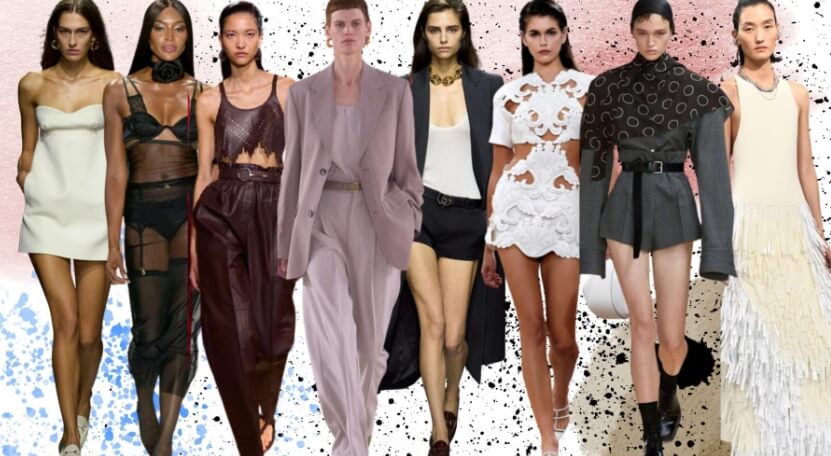The rise of secondhand clothing sales in 2024 is closely tied to one key factor: the power of trending styles. Shoppers are increasingly looking for budget-friendly yet trendy options, and secondhand clothing offers just that. Whether it’s the return of 90s fashion or the latest streetwear craze, consumers are finding that thrift stores and resale sites offer access to stylish items that reflect current fashion movements. This shift is transforming the landscape of the fashion industry and pushing secondhand shopping into the mainstream.
The Impact of 90s Fashion Revival on Secondhand Sales
The revival of 90s fashion has had a significant impact on secondhand clothing sales in 2024. As nostalgic trends from the decade—such as oversized denim jackets, slip dresses, and chunky sneakers—resurface in mainstream fashion, shoppers are turning to secondhand stores and online resale platforms to find authentic vintage pieces. This demand has caused a noticeable spike in secondhand clothing sales, as consumers seek out items that not only capture the essence of 90s style but also offer the sustainable and budget-friendly appeal that secondhand shopping provides. The continued popularity of these retro trends is expected to keep driving growth in the resale market.
How the return of 90s trends has boosted demand for vintage clothing
The resurgence of 90s fashion has significantly boosted demand for vintage clothing, contributing to the rise in secondhand clothing sales. As more consumers look for ways to incorporate nostalgic pieces into their wardrobes, secondhand retailers are seeing an influx of interest in authentic vintage items from the decade. From grunge-inspired looks to minimalist slip dresses, shoppers are gravitating towards styles that evoke the bold and carefree spirit of the 90s. This trend has helped drive secondhand clothing sales, with many buyers opting for pre-loved pieces to capture the era’s iconic fashion while embracing sustainable shopping.
Popular 90s styles that are driving secondhand market growth
Popular 90s styles such as oversized flannel shirts, baggy jeans, and platform shoes are key drivers of secondhand market growth. These iconic pieces, once staples of 90s streetwear, have made a major comeback in recent years, leading shoppers to seek them out in thrift stores and resale platforms. Secondhand clothing sales have benefited greatly from this demand, as consumers turn to vintage and secondhand shops to find authentic versions of these in-demand styles. The trend towards embracing retro fashion not only supports sustainability but also keeps secondhand markets thriving with a steady stream of fashion-forward buyers.
Streetwear Craze: Fueling Resale Demand
The streetwear craze has been a major force in fueling resale demand, significantly boosting secondhand clothing sales. With the rise of hype-driven brands and limited-edition collaborations, many streetwear enthusiasts are turning to the secondhand market to find rare or sold-out pieces. Items like graphic hoodies, vintage sneakers, and oversized jackets are in high demand, with resale platforms becoming the go-to destination for fashion-conscious buyers. This surge in popularity has not only driven secondhand clothing sales but also solidified streetwear as a dominant trend within the resale market, where exclusivity and authenticity are key selling points.
The rise of streetwear and its influence on secondhand clothing sales
The rise of streetwear has had a profound influence on secondhand clothing sales, particularly as the line between luxury fashion and casual wear continues to blur. Streetwear’s dominance, driven by exclusive drops and limited-edition releases, has pushed many shoppers to look for alternative ways to access these sought-after pieces. As a result, secondhand clothing sales have surged, with resale platforms becoming the prime destination for those seeking hard-to-find streetwear items. This shift in consumer behavior reflects the growing trend of purchasing pre-owned fashion not just for affordability, but to own a piece of the culture that streetwear represents.
Key streetwear pieces that are popular in the resale market
Key streetwear pieces such as limited-edition sneakers, graphic tees, and branded hoodies are among the most popular items driving growth in the resale market. These pieces, often associated with brands like Supreme, Off-White, and Yeezy, hold immense value in the secondhand space due to their exclusivity and cult following. As demand for these items continues to rise, secondhand clothing sales benefit from the high resale value and constant turnover of these coveted fashion staples. The appeal of owning iconic streetwear pieces keeps the secondhand market thriving, especially for trend-conscious consumers seeking both style and rarity.
Social Media’s Role in Shaping Secondhand Fashion Trends
Social media has played a pivotal role in shaping secondhand fashion trends, driving significant growth in secondhand clothing sales. Platforms like Instagram, TikTok, and Pinterest have turned thrifted outfits and vintage pieces into viral sensations, encouraging users to share their unique finds and styling tips. Influencers and fashion bloggers often showcase secondhand clothing as both a trendy and sustainable choice, sparking interest among their followers. This visibility has fueled the demand for secondhand items, as more consumers look to replicate these curated looks. As a result, secondhand clothing sales have experienced a steady rise, with social media continuing to amplify the appeal of thrifted fashion.
How platforms like Instagram and TikTok are driving secondhand shopping trends
Platforms like Instagram and TikTok are driving secondhand shopping trends by creating a space where fashion enthusiasts can showcase their unique thrifted outfits and sustainable choices. These platforms have transformed secondhand shopping into a popular cultural movement, with influencers frequently promoting thrift hauls, styling videos, and tips on finding hidden gems. This online visibility has significantly increased secondhand clothing sales, as more users are inspired to shop secondhand and participate in the growing movement of sustainable fashion. The ease of sharing and discovering secondhand fashion on social media has made it a key driver of resale market growth.
Viral fashion moments and their impact on secondhand sales
Viral fashion moments, often sparked by social media influencers or trending hashtags, have had a major impact on secondhand clothing sales. From celebrity thrifted looks to sudden revivals of vintage trends, these moments create an instant surge in demand for similar secondhand pieces. When a specific style goes viral, shoppers flock to resale platforms in search of items that replicate the look, causing a noticeable boost in secondhand clothing sales. These viral trends not only raise awareness of secondhand fashion but also contribute to the cyclical nature of style, where past trends are continuously reintroduced through social media.
Sustainability Meets Style: Why Shoppers Are Opting for Secondhand Fashion
As sustainability becomes a priority for many consumers, the appeal of secondhand fashion is growing rapidly, leading to a notable increase in secondhand clothing sales. Shoppers are increasingly aware of the environmental impact of fast fashion and are opting for pre-loved clothing as a more eco-friendly alternative. Secondhand fashion not only reduces waste but also allows consumers to express their personal style with unique, one-of-a-kind pieces. This blend of sustainability and individuality is driving more people to explore thrift stores and online resale platforms, making secondhand clothing sales a key component in the shift towards more conscious fashion choices.
The growing importance of sustainability in fashion choices
The growing importance of sustainability in fashion choices has significantly influenced consumer behavior, leading to a rise in secondhand clothing sales. As awareness of the environmental impact of the fashion industry increases, shoppers are becoming more discerning about their purchasing decisions. Many consumers now prioritize eco-friendly options, seeking out brands and products that align with their values. This shift has led to an increased interest in secondhand clothing, as it offers a sustainable alternative to new fast fashion, allowing individuals to reduce their carbon footprint while still enjoying stylish and trendy pieces.
How consumers are blending eco-consciousness with trend-driven shopping
Consumers are increasingly blending eco-consciousness with trend-driven shopping, resulting in a remarkable surge in secondhand clothing sales. Today’s shoppers want to stay fashionable while also making responsible choices that benefit the environment. This desire for sustainability is driving them to explore thrift stores and online resale platforms for trendy items that reflect current styles. As a result, secondhand clothing has become synonymous with both affordability and individuality, allowing consumers to curate unique wardrobes without compromising their commitment to sustainable fashion practices. This combination of eco-awareness and style consciousness is reshaping the landscape of the fashion industry.
Challenges and Opportunities for Secondhand Retailers
Secondhand retailers face both challenges and opportunities in the evolving fashion landscape, particularly as secondhand clothing sales continue to rise. One significant challenge is the competition from online resale platforms that offer a vast selection of items and streamlined shopping experiences. However, this also presents an opportunity for brick-and-mortar stores to differentiate themselves by providing curated collections and personalized customer service. By embracing technology, such as social media marketing and e-commerce solutions, secondhand retailers can reach a broader audience and enhance their visibility. Additionally, emphasizing the unique stories behind each item can create a deeper connection with consumers, ultimately driving secondhand clothing sales and fostering brand loyalty in a crowded market
Adapting inventory to reflect trending styles
To remain competitive in the thriving secondhand market, retailers must adapt their inventory to reflect trending styles, a strategy that can significantly boost secondhand clothing sales. By closely monitoring fashion trends and consumer preferences, retailers can curate collections that resonate with current demands. This approach not only helps in attracting trend-conscious shoppers but also enhances the overall shopping experience by ensuring that popular styles are readily available. Additionally, effective marketing strategies play a crucial role in engaging this audience.
Marketing strategies for attracting trend-conscious shoppers
Utilizing social media platforms, influencer partnerships, and targeted advertising can help secondhand retailers showcase their inventory and highlight the unique aspects of their offerings, ultimately driving secondhand clothing sales and increasing brand awareness in the crowded marketplace.
The Future of Secondhand Clothing Sales
The future of secondhand clothing sales looks promising as consumer attitudes toward sustainability and unique fashion continue to evolve. As more people recognize the environmental benefits of shopping secondhand, the market is expected to expand significantly, driven by an increasing number of eco-conscious shoppers. Innovations in technology, such as augmented reality fitting rooms and improved online resale platforms, will enhance the shopping experience, making it easier for consumers to find and purchase pre-loved items. Additionally, collaborations between secondhand retailers and trendy brands could further elevate the appeal of secondhand clothing sales, attracting a broader audience. With these factors at play, the secondhand market is poised for sustained growth, solidifying its place in the future of fashion.



